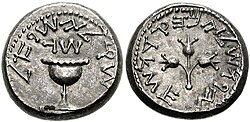First Jewish–Roman War
The First Jewish–Roman War was the first and biggest of the Jewish–Roman wars in the Judaea province. It is often called The Great Revolt. It happened from 66–70 AD, and ended with the Empire winning.
It began in 66 AD in Caesarea, where there was religious tension between the Greek and Jewish population. It turned into an anti-taxation protest against Rome. In Caesarea, the Greeks sacrificed animals in front of a Jewish Synagogue. This resulted in the Jews ceasing sacrifices to the Roman Emperor. General Gallus went up against the rebels and lost a crucial battle at Beth Horon in 68 AD.
After this defeat, Emperor Nero replaced Gallus with Vespasian. He crushed the Northern and Southern leadership and the rebellion began to fall apart. Later that year, Nero was deposed. The Roman forces besieged Jerusalem and breached the walls by 70 AD. Once they got into the walls, the Roman soldiers burned and ransacked the city also destroying the Second Temple. The final stronghold at Masada was taken in 73 AD and when the Roman soldiers broke through the defences, they discovered all the defenders had committed suicide. As a result, most of the Jews in the area were scattered or sold into slavery. The final death toll, according to Josephus who was often wrong about numbers, was over one million.
First Jewish–Roman War Media
Scale model reconstruction of the Temple Mount during the first century CE, with the Second Temple in the center and the Antonia Fortress to the upper right
A coin issued by the rebels in 68, using the Paleo-Hebrew alphabet. Obverse: "Shekel, Israel. Year 3." Reverse: "Jerusalem the Holy"
Coins from the Year of the Four Emperors. Following Nero's death in June 68, a delay of about a year occurred, during which Vespasian left Judaea to contest the imperial throne
The destruction of the temple of Jerusalem, painting by Francesco Hayez, 1867
A pile of stones beneath the Western Wall, thrown down by Roman legionaries from the Temple Mount during its destruction, now preserved in the Jerusalem Archaeological Park
The Triumph of Titus, painting by Lawrence Alma-Tadema, 1885
After the revolt, a new tax, the Fiscus Judaicus, was imposed on all Jews in the Empire. Pictured is a receipt of payment from Edfu
An inscription referencing Legio X Fretensis, a legion stationed on Jerusalem's ruins










